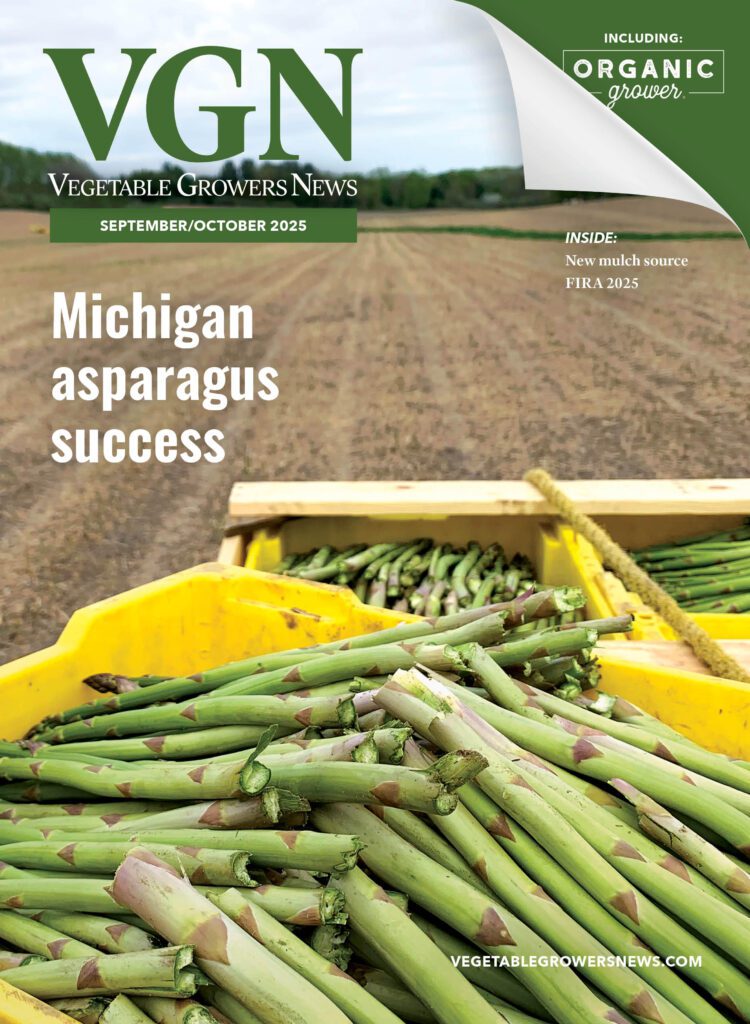Dec 21, 2009Mechanical Asparagus Harvester Almost a Reality
After more than a century of experimentation, the U.S. asparagus industry just might be on the verge of getting itself a workable, economical mechanical harvester.
Since 1908, 57 patents for some sort of mechanical asparagus harvester have been filed, but none have reached fruition; hundreds of models have been designed – and abandoned. It’s been a difficult process, to say the least, said Kim Haws, owner of Agri-TRAC Inc., a farm machinery manufacturer in Mesa, Wash.
Haws might have cracked the code, however. He’s designed a machine that can pick asparagus almost as efficiently as hand labor – and at a cheaper cost. If everything goes as planned, the machine will be on the commercial market some time in 2010, he said.
He described the Haws Harvester as the first machine that’s ever selectively harvested a crop – not just asparagus, but any crop. It can sort mature spears from immature spears, which has never been done before.
“It’s a machine that thinks,” he said. “It’s remarkable to watch it work.”
Asparagus grows out of the ground at random. Each spear matures at a different speed, making it difficult to achieve a uniform harvest. The Haws Harvester can go through a field at 4 miles per hour and pick all the spears that are tall enough, while leaving the immature spears undamaged so they can be picked when they’re ready, Haws said.
The key is a light-beam sensor. When the self-propelled, four-wheeled machine goes over a row of asparagus plants, the taller spears trip the sensor. When a spear breaks the light beam, a mechanism is dispatched to cut that spear and throw it onto a conveyor belt. The spear is carried to a sorting table on top of the machine, where human workers either sort it or, if it’s unacceptable, leave it on the belt – which drops it back on the ground.
The harvester cuts 80-90 percent of the marketable spears in a field. It requires one driver and one to four sorters, depending on the amount of asparagus you’re dealing with. It’s 10 feet wide, 15 feet long, about 9 feet high and weighs 7,500 pounds, Haws said.
The machine has come a long way since 1971, when Haws first started working on it. A former asparagus grower, he’s made about 15 prototypes. An earlier version was on the market for a while in the early ’80s, but it was big and slow and couldn’t sort spears, so it didn’t catch on. The new machine is much improved, he said.
Growers have shown interest in the Haws Harvester, which could go a long way toward solving their labor problems. Its availability won’t be limited to Washington state, either. Growers in other parts of the country, like asparagus-heavy California and Michigan, will be able to purchase it. The machine will probably cost about $250,000, Haws said.
Field trial
Haws is working with Washington State University to test his new machine. WSU researchers ran a trial on a leased commercial asparagus field from June 4-16 to compare the harvester’s costs and benefits with those of hand labor.
Shannon Neibergs, an associate professor and economist with WSU Extension, was the main author of an economic analysis that summarized the field trial’s findings. He stressed that the harvester was not tested over a full season, but the results from the 12-day trial were projected over a full season – assuming the same efficiency levels – to give growers a rough idea of the costs and benefits. An actual full-season trial is scheduled for 2010, he said.
Here are some excerpts from the economic analysis of the 2009 trial:
The hand harvesters were trained and paid an hourly wage to ensure they did their work as efficiently as possible.
If the machine runs 10 hours, at a field speed of 4 miles per hour and a field efficiency of 85 percent, it can harvest 40 acres in a day.
The machine’s harvest revenue was $144,452, compared to $168,840 for hand harvesting. The difference is the lower mechanical harvesting efficiency compared to hand labor. Engineering research on the harvester is ongoing to minimize this difference. However, using the machine cost $35,617 less than using hand harvesters, giving the operator a net gain of $11,229.
The higher the yield and the longer it’s run, the more economical the machine becomes. The piece rate paid to hand harvesters increases in direct correlation to yield increases, while the mechanical harvester’s labor costs increase only slightly.
Hand labor is very efficient when it comes to combing fields and selecting the most marketable spears. Mechanical harvesters, traditionally, have not been as efficient. That’s been their major constraint, but the Haws Harvester has gone a long way toward closing the gap, Neibergs said.
“Growers are excited about the efficiency demonstrated in the field trial,” he said. “It’s a viable option.”
Washington State University provided a video of the Haws Harvester. To see it in action, click here.
















